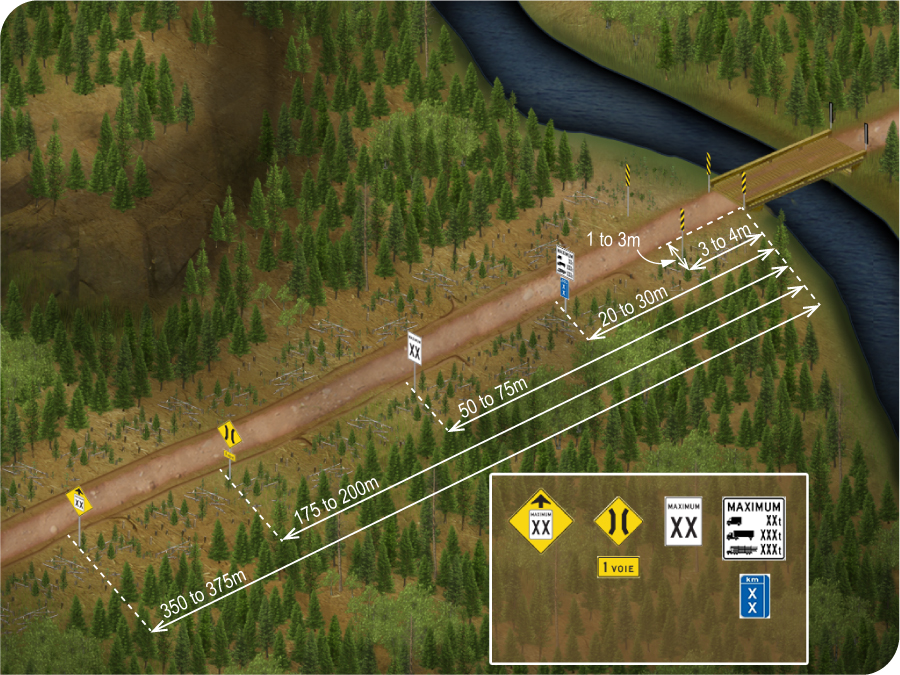Chapter V – Roads, sandpits and forest infrastructures
Division IV – Road signs
§2. Provisions applicable to bridges
Section 117
Every person authorized to build or improve a bridge must, at the end of the work, post at each end of the bridge the following elements: hazard markers signalling the limits of the bridge deck, the indication of a narrow crossing, the maximum load the bridge may support based on the types of vehicles and the speed allowed for crossing the bridge. The foregoing also applies to a person who repairs a bridge.![]()
All signs and tab signs must be installed with care, facing the vehicles, so as to be perfectly visible even at night. No obstacle such as vegetation or a snow bank must reduce the visibility of the signs or tab signs.![]() They must comply with the standards in the Guide de signalisation routière sur les terres du domaine de l’État
They must comply with the standards in the Guide de signalisation routière sur les terres du domaine de l’État ![]() (in French only), published by the Minister responsible for the administration of the Sustainable Forest Development Act
(in French only), published by the Minister responsible for the administration of the Sustainable Forest Development Act ![]() (chapter A-18.1).
(chapter A-18.1).![]()
2
Objective
- To ensure the safety of forest road users
3
Objectives
- To ensure the safety of forest road users
- To ensure that road signs are consistent
Additional information
Trail signs exclusively for all-terrain motorized vehicles
Trail signs intended exclusively for all-terrain motorized vehicles is governed by the Act respecting off-highway vehicles (CQLR, Chapter V-1.3)  and its Regulation respecting off-highway vehicle trail signs (Chapter V-1.2, r. 4.1)
and its Regulation respecting off-highway vehicle trail signs (Chapter V-1.2, r. 4.1)  . The posting of a bridge constructed, improved or resurfaced on a trail solely for all-terrain motorized vehicles shall comply with section 117. The maximum load the bridge can support and the speed allowed to cross it must be posted using the following signs: Sign P-200-3 (weight restriction), 20 metres on either side of the bridge, and Sign P-70-2 (speed limit), located 40 metres on either side of the bridge.
. The posting of a bridge constructed, improved or resurfaced on a trail solely for all-terrain motorized vehicles shall comply with section 117. The maximum load the bridge can support and the speed allowed to cross it must be posted using the following signs: Sign P-200-3 (weight restriction), 20 metres on either side of the bridge, and Sign P-70-2 (speed limit), located 40 metres on either side of the bridge.
A vehicle whose total loaded mass exceeds the mass posted on site pursuant to the first paragraph may not travel on the bridge of a road. ![]()
4
Objectives
- To ensure the lifespan of a road, bridge or culvert
- To ensure the safety of forest road users
Additional information
Request to travel over a bridge with a very heavy load
The owner of a truck who wishes to travel over a bridge with a load in excess of that permitted must obtain a permit for very heavy loads. The issuance of permits is limited to the transportation of non-divisible loads. The procedure for obtaining the permit is described in the application procedure: permit for very heavy loads ![]() (in French only).
(in French only).

